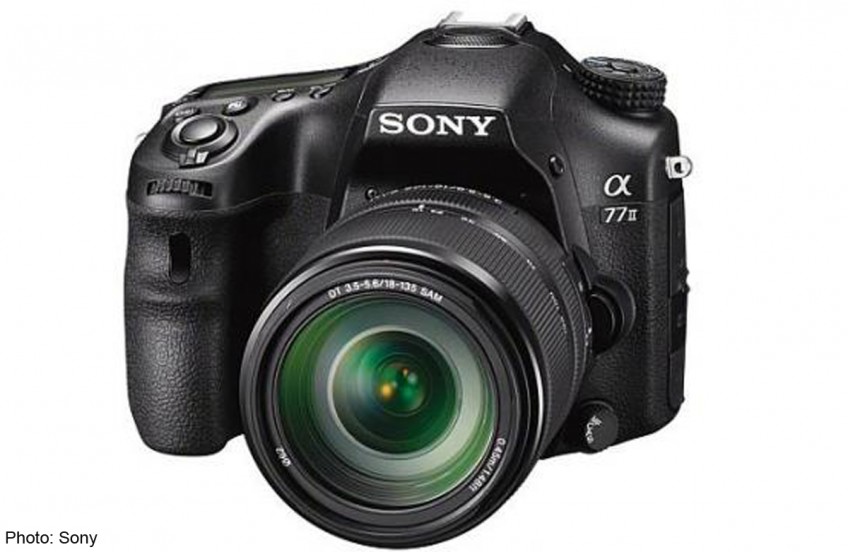Sony A77 II

With Sony basking in the success of its mirrorless cameras, such as the NEX-7 and a7R, the company had failed to release any new Single Lens Translucent (SLT) camera for the past two years.
The SLT cameras use a fixed translucent mirror to direct light simultaneously to the image sensor and autofocusing sensor, instead of a flipping mirror used in DSLRs.
Sony's proprietary translucent mirror technology significantly reduces the autofocusing or AF lag when the display or live view is used to shoot. But the SLT is still more bulky than a mirrorless camera that does away with the mirror altogether. So, it was quite a surprise when Sony released a new SLT camera, the a77 II, a long-awaited successor to the three-year-old a77.
Although both cameras have athe same 24.3-megapixel count, the a77 II's APS-C image sensor is new and comes with the latest Bionz X image processor.
The newcomer's most significant improvement is in its a79 phase-detection AF points, including 15 cross points within the central area of the sensor, which has twice the coverage area of the older camera's 19 AF points.
Sony says a brand new AF algorithm is used to process the metering data from those 79 AF points, to anticipate a subject's next movement, so that moving objects are captured fast and sharp.
I am not altogether sure what the tech speak amounts to, but using the DT 16-50mm f/2.8 SSM lens, I found the a77 II's AF performance to be stunningly swift and accurate, better than some professional DSLRs.
Whether you use the electronic viewfinder or LCD monitor, the AF is instantaneously on the mark in bright sunlight. Even in dim light, the AF can secure a focus in less than a second. If you use the built-in flash as AF assist light, near instant focus can sometimes be achieved.
During video recording, the AF secures a focus in a split second when you pan from one scene to another or refocus from a distant object to a nearby one.
For those intending to shoot speedy toddlers or sports in still or moving images, this camera is ideal.
But start-up is not instantaneous. Powering up and shutting down takes about one second. Shutter lag, though, is almost non-existent.
Using an SD card with a writing speed of 45MB per second, the a77 II was able to shoot 29 RAW images in 3.8sec before the buffer ran out. Shooting JPEG images, it clocked 80 frames in 12.5sec before it slowed to a crawl.
With its tough magnesium alloy body, this camera feels really sturdy. It is weather-sealed to be dust-resistant and moisture-resistant.
The rubberised contoured grip and prominent thumb rest make for a superbly comfortable grasp accommodating all my fingers. It might be heavier than a mirrorless camera but it will not make your shoulders ache.
There are plenty of buttons and controls to delight the professionals and put off the pretenders. But the button layout is among the best in the market.
There is a Mode dial found on the top left of the camera and a command dial in front of the shutter release. At the back is a command dial and a directional joystick, with a thumb rest in between, so your thumb can easily access both. This makes changing settings a breeze.
Some examples of thoughtful placements include:
AF mode dial on the bottom left of the camera; Function and Display buttons under the joystick; AF button beside rear command dial; and A dedicated video recording button. The handling is second to none. And I can say that from having reviewed cameras for 10 years.
In addition, the display, albeit not a touchscreen, uses a swivel-and-tilt joint attached to a hinge that can be folded out from the camera's rear. So you can twist and turn the display to almost any angle you like - even facing you - if you are a selfie lover.
But great build and handling come to naught if the image quality is not up to the mark.
Fear not. The image quality is excellent, with sharp rendition of pixels and vivid colours. Auto white balance is spot on in most lighting conditions.
There is, however, a slight softness at the edges of the frame when using large apertures, such as f/2.8 or f/4. That softness disappears when you change the aperture to f/8 or f/11.
Noise performance is stellar with no visible noise artefacts until ISO 1,600. Even at ISO 3,200, it is not much of a problem except in the darker areas. I would have no qualms shooting at ISO 6,400 too, but nothing above that.
Video quality is crisp. It picks up little ambient audio or sounds from the AF motor, although the sound of zooming can be readily heard.
Probably the only downside is its battery. On a full charge, it is able to shoot around 480 still images, while some higher-end DSLRs can shoot up to 700 still images.
Simply put, Sony's α77 II is an amazingly fast interchangeable lens camera with excellent build, superb handling and great image quality at a surprisingly affordable price.
trevtan@sph.com.sg
BACKGROUND STORY
TECH SPECS
Price: $1,599 (body only); $2,399 (with DT 16-50mm f/2.8 SSM lens)
Image sensor: 24.3-megapixel Exmor APS-C CMOS
Display: 3-inch tiltable LCD with 1,229,000 dots; electronic viewfinder with 2,359,296 dots
Sensitivity: ISO 50 to 25,600
Shooting speed: Up to 12 frames per second
Connectivity: Wi-Fi, Near Field Communication
Weight: 647g (body only)
RATING
Features: 5/5
Design: 5/5
Performance: 4/5
Value for money: 5/5
Battery life: 3/5
Overall: 4/5
This article was published on Aug 13 in Digital Life, The Straits Times.
Get a copy of Digital Life, The Straits Times or go to straitstimes.com for more stories.